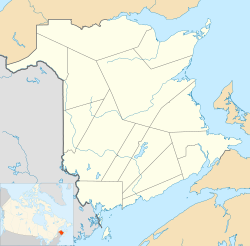Baker Brook, New Brunswick
| Village of Baker-Brook | |
|---|---|
| Village | |
 |
|
| Location of Baker-Brook, New Brunswick | |
| Coordinates: 47°18′09″N 68°30′36″W / 47.3025°N 68.51°W | |
| Country |
|
| Province |
|
| County | Madawaska |
| Parish | Baker Brook |
| Village Status | 1967 |
| Electoral Districts Federal |
Madawaska—Restigouche |
| Provincial | Madawaska-les-Lacs |
| Government | |
| • Type | Village Council |
| • Mayor | Francine Caron |
| • Councillors |
List of Members
|
| Area | |
| • Total | 12.29 km2 (4.75 sq mi) |
| Population (2011) | |
| • Total | 585 |
| • Density | 47.6/km2 (123/sq mi) |
| • Change 2006-11 |
|
| • Census Ranking | 2,944 of 5,008 |
| Time zone | AST (UTC-4) |
| • Summer (DST) | ADT (UTC-3) |
| Area code(s) | 506 |
| Dwellings | 236 |
| Median Income* | $37,983 CDN |
| Access Routes |
|
|
|
Baker-Brook (2011 population: 585) is a village in Madawaska County, New Brunswick, Canada.
It is located on the Saint John River 20 kilometres west of Edmundston.
The village takes its name from 19th-century sawmill businessman John Baker.
In 1818, Baker, a native of Maine, settled in the area, along with several other American families. He was dissatisfied with the official borders, and in 1827 declared the village to be capital of the "Republic of Madawaska", a self-proclaimed unrecognized sovereign state being part neither of the United States nor of British America (Canada) although comprising portions of both. Baker was subsequently briefly jailed by the British for treason. A US citizen by birth, John Baker continued to live on his settlement as a somewhat reluctant British subject after Baker Brook was officially declared part of New Brunswick.
Population trend
Mother tongue language (2006)
The local Roman Catholic church, houses noted religious artwork, including stained-glass windows from the workshop of Belgian artist José Gaterrath and the Stations of the Cross by the famous Spanish ceramist Jordi Bonet.
Coordinates: 47°18′09″N 68°30′36″W / 47.30250°N 68.51000°W
...
Wikipedia

